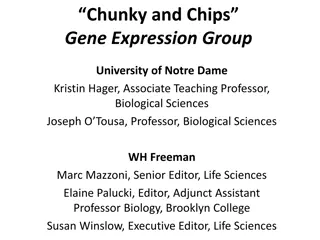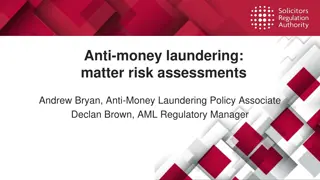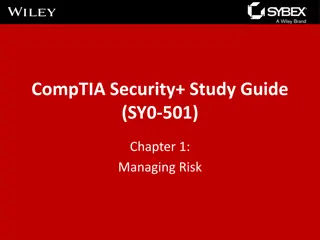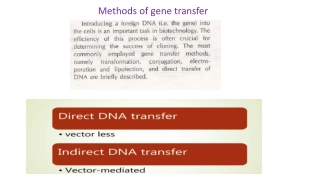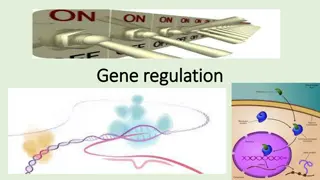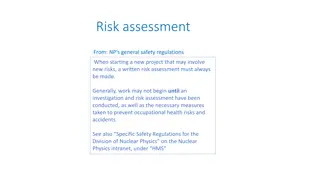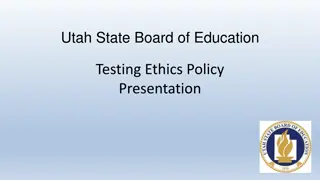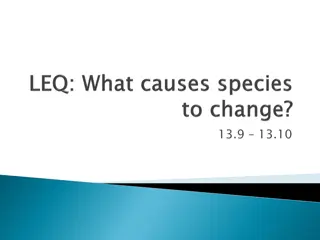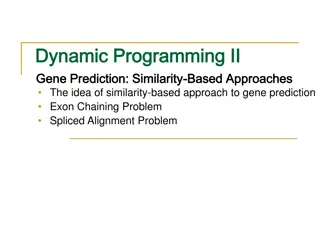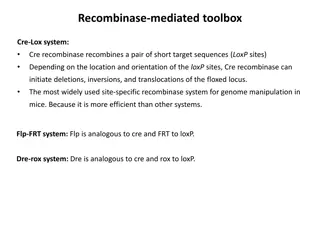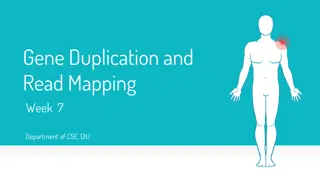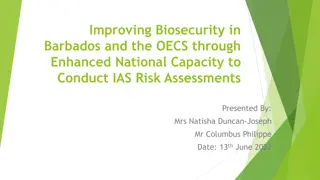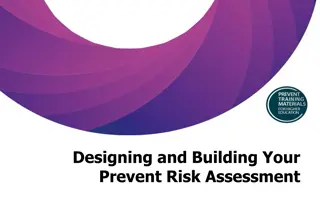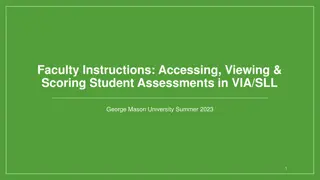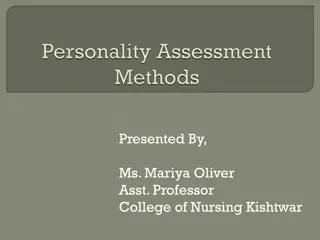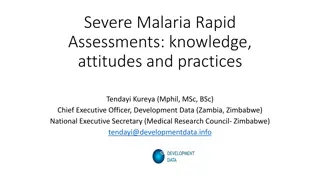Co-Developing Risk Assessments in Gene Drive
Gene drive technology is a cutting-edge approach aimed at combating malaria by spreading genetically modified genes in mosquito populations. This technology has the potential to protect endangered species and conserve nature. However, successful implementation requires complex collaborations, risk assessment frameworks, surveillance, monitoring, and public engagement. There are challenges and resistance to the use of gene drive technology in African countries like Uganda, which are heavily impacted by malaria. Scientists aim to influence a more inclusive and multidisciplinary approach to risk assessment for gene drive projects.
Download Presentation

Please find below an Image/Link to download the presentation.
The content on the website is provided AS IS for your information and personal use only. It may not be sold, licensed, or shared on other websites without obtaining consent from the author. Download presentation by click this link. If you encounter any issues during the download, it is possible that the publisher has removed the file from their server.
E N D
Presentation Transcript
CO-DEVELOPING RISK ASSESSMENTS IN GENE DRIVE By Prof.Charles B. Rwabukwali Social Science Agenda for Gene Drive Research Workshop 19 May 2021, Kampala 1
Project team Ben Raymond College of Life Sciences University of Exeter Principal Investigator Principal Investigator Sarah Hartley University of Exeter Tibebu Habtewold Department of Life Sciences Imperial College London Co Co- - Investigators Investigators Charles B. Rwabukwali Department of Sociology & Anthropology Makerere University Robert Smith University of Edinburgh Adam Kokotovich Dept. of Forestry & Environmental Resources North Carolina State University George Ladaah Openjuru Department of Education Gulu University Katie Ledingham Department of Geography University of Exeter 2
Introduction Gene drive = cutting-edge technology involving spread of genetically modified genes in plant or animal populations Being developed to eliminate malaria-carrying Anopheles gambiae mosquito to eradicate malaria Has potential to protect endangered species and conserve nature Increases frequency of desired gene into mosquito population through reproduction in small generations 3
Gene drive technology in Uganda Malaria is leading cause of morbidity and mortality in sub-Saharan Africa, Uganda inclusive In 2019, WHO African Region was home to 94% of malaria cases and deaths First candidates for adoption of gene drive to combat malaria will be in sub-Saharan Africa e.g. Mali and Burkina Faso July 2019- Limited release of non gene drive genetically modified sterile mosquitoes in Burkina Faso Riots and resistance to release of sterile genetically modified mosquitoes reported in Burkina Faso Imminent challenges for use of gene drive in eradicating malaria 4
Requirements for gene drive Gene drive is complex and requires collaborations across disciplines and borders The technology requires establishment of risk assessment frameworks for potential harms and benefits Surveillance and monitoring of post release behaviour and feedback from local communities and stakeholders is paramount Public engagement, especially in developing risk frameworks on harms and benefits of gene drive 5
The Problem Scientists most likely to influence traditional top-down approach to risk assessment for gene drive in developing countries like Uganda To social scientists, this expert-led approach is narrow, linear, ignores the complexities of gene drive. We contest it. The way forward The way forward: Open up the risk assessment process to a broader range of voices and consideration Give opportunities to all categories of Ugandans to identify risks and benefits of gene drive that matter to them Aim at inclusivity so that gene drive reflects diverse publics, including academia, civil society and lay actors The real problem The real problem: There is little guidance surrounding who is to be involved in risk assessment, when to involve them and why. That s the rationale for this study. 6
Objectives of our study To understand the range of expertise required for risk assessment, who has such expertise and how can they best be engaged Develop and test an empirical and theoretical grounded model for opening up risk assessment in interdisciplinary research Explore the value of an experimental learning model using cases of gene drive risk assessment in other countries as bench marks 7
Theoretical framework Based on theoretical concept of co-development Co-development is promoted as a governance approach to interdisciplinary gene drive research No one discipline has monopoly over all the answers It is essential to have interdisciplinary teams that bridge natural and social sciences 8
Work plan Documentary analysis of policy and regulatory documents, news articles, position papers to explore existing risk assessment work on gene drive, domestically and globally Conduct semi-structured face-to-face interviews with selected Ugandan stakeholders e.g. public health officials, regulators, policy makers, community and civil society groups to explore range of risks/ impacts relevant to Ugandans. Include persons working directly with gene drive, Ugandan scientists promoting gene drive Ugandan scientists opposed to gene drive, professionals living outside Uganda but write about gene drive developments in Uganda 9
The interview process Examining international and national actors agitating for opening up gene drive risk assent and why Identifying key actors shaping risk assessment in Uganda Identifying risks/ impacts of gene drive presented in policy documents Determining the most important risks/ impacts that stakeholders want included in risk assessment 10
The interview experience We underestimated the amount of time it would take for conduct field work Gene drive is controversial and many potential participants dodged us Some assumed we were natural scientists trying to introduce gene drive in Uganda Its an uphill task getting some people s contact information e.g. phone, email address Many participants did not want to be voice-recorded 11
Outputs Three stakeholder workshops in Uganda, USA and the UK, to: present project findings to stakeholders Generate mutual learning (experimental learning) Examine for scaling up our approach in gene drive research in other countries Develop a larger grant proposal on gene drive, linking the UK, USA, Uganda, Burkina Faso and Mali Prepare 2-page policy-relevant report to be disseminated to national and international stakeholders Prepare academic papers 12
Key themes emerging from the data Lack of awareness of gene drive No clear distinction between GU and GD A culture of mistrust and fear, especially regarding the motives of the global North Issue of reversibility. How might a release of gene drive mosquitoes be undone or nullified if need be? 13
References Benedict, M., Abbs, D., Dobson, S., Gottlieb, M., Higgs, S., et al. Guidance for contained field trials of vector mosquitoes engineered to contain a gene drive system: Recommendations of a scientific working group. Vector-borne and zoonotic diseases, 2008; 8 (2): 127 166. Burt, A. and Crisanti, A., 2018. Gene drive: Evolved and synthetic. ACS Chem Biol 13 (2): 343 346 Hartley, S., Thizy, D., Ledingham, K., Coulibaly, A., Dicko, A., Dop, S., Kayondo, J., Namukwaya, A., Nourou, B., Toe Pare, 2019. Knowledge engagement in gene drive research for malaria control. PLOS Neg Trop D15 3 (14): 1-5 NASEM (National Academies of Science, Engineering and Medicine). Gene Drives on the Horizon. Advancing Research with Public Values, 2016. Washington DC: National Academies Press 14
Funding for this project is from the British Academy Photo credits: Unsplash Genetic Literacy Project North Carolina State University Researchgate University of Exeter 15
Thank You Charles B. Rwabukwali Charles.Rwabukwali@mak.ac.ug 16






